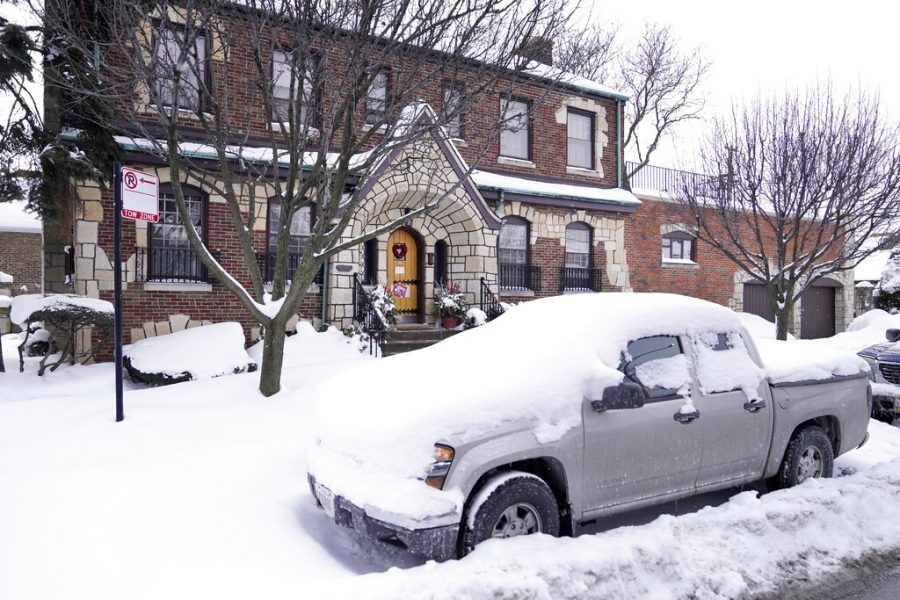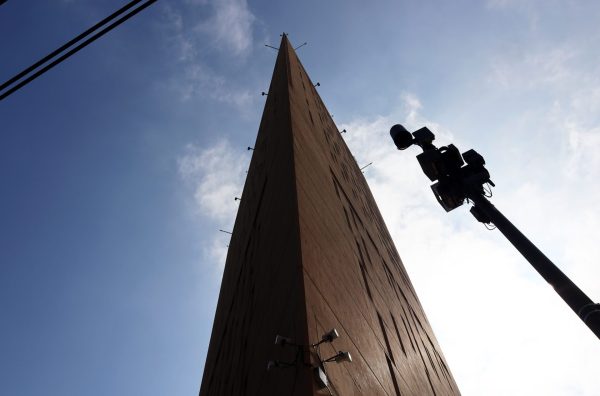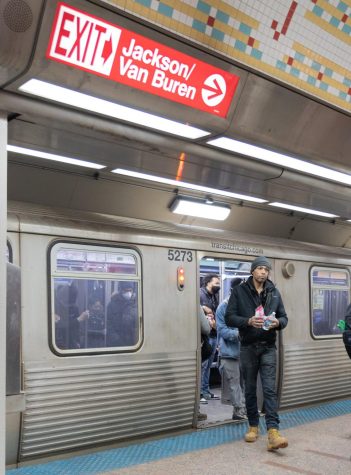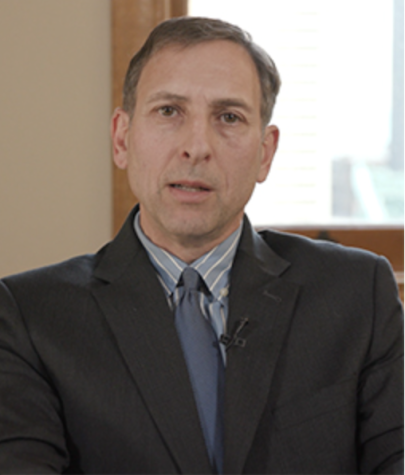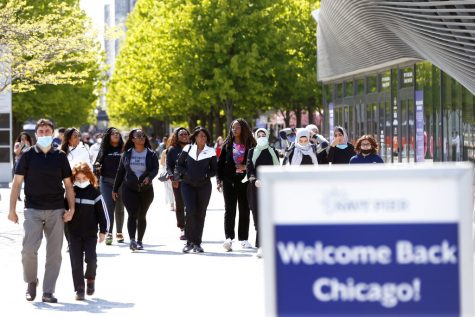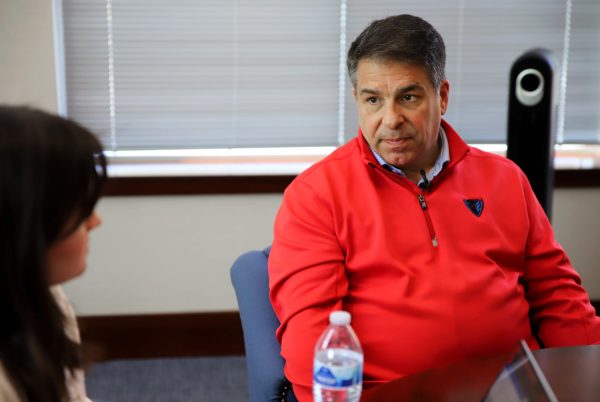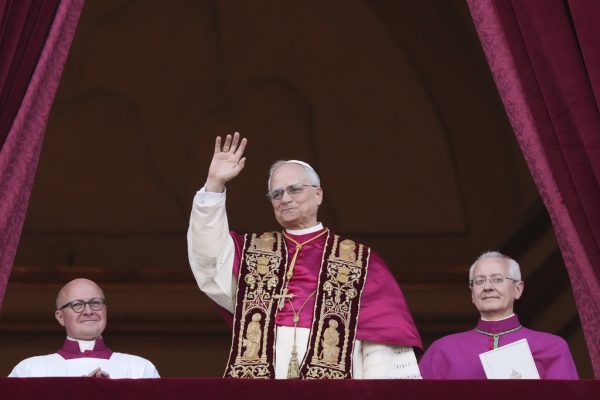Uber prices skyrocketed to inaccessible costs during Chicago snowstorm
A snow covered truck sits outside the home of former Illinois House Speaker Michael Madigan Thursday, Feb. 18, 2021, near Midway International Airport in Chicago. Madigan announced his resignation from the Illinois House Thursday, after representing a Southwest Side Chicago area district for a half-century. (AP Photo/Charles Rex Arbogast)
As temperatures in Chicago plummeted last month, Uber and rideshare prices soared.
On Feb. 15, after a storm swept Illinois with a sheet of snow, Governor J.B. Pritzker issued a disaster proclamation, encouraging people to stay indoors. Cars were buried in several inches – or feet – of snow. Power outages were seen across the state, and freezing temperatures made driving and traveling conditions slick and dangerous.
Despite the proclamation and amid a global pandemic, thousands of Chicagoans and Illinois residents still had to travel to get to work. Frigid temperatures and wind chill made walking and waiting for public transportation unbearable, cars were covered with ice or stuck in piles of snow and sidewalks or street ways were poorly shoveled.
Makayla Vasquez, a second-year student at Joliet Junior College uses Uber – a worldwide rideshare company – up to two to three times a week as her primary way to get to work. As a regular user, she noticed that last week’s prices were a bit higher than usual.
“Normally prices fluctuate pretty constantly, but it was the first time I noticed it was very different,” Vasquez said. “I even made sure it had the correct address in and it didn’t think I was going further.”
After the storm, the temperature for Feb. 15 was a high of 12.2 degrees and a low of -0.4 degrees – before considering wind speed and chill.
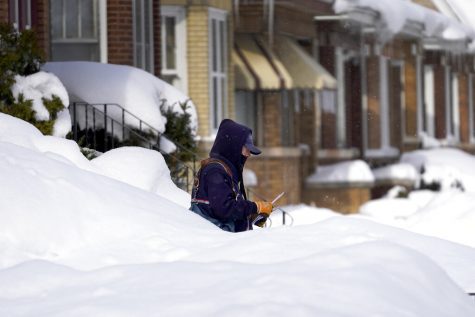
“I know that the weather has been making it harder for people to find rides because no one wants to drive in this weather, even the Uber driver,” Vasquez said. “I normally schedule my Ubers in advance and last week was the first time the Uber app couldn’t find me a driver until after my scheduled time even though I scheduled almost 12-14 hours in advance.”
Vasquez’s trips to work usually cost her anywhere between $13 and $15 before tip, but on Feb. 18 and 19, her prices were between $18 and $20.
While it might not sound like a stark increase, those costs are noticeable to customers when they depend on the service and use it two or three times a week – or multiple times a day. Vasquez’s shifts are typically four to five hours long. She shared that whenever she has to pay $40 a day for Ubers, the whole day’s pay becomes just the cost to get to work.
“See, Uber is very different from a taxi, it’s not regulated in the same way,” said Dr. Tim Smith, a professor in DePaul’s marketing department. “They’re [Uber] just trying to match supply and demand and take a cut of every dollar that goes through their system. And right now, in Chicago, there’s not a lot of drivers on the road because of the snow, it’s dangerous, and then you’ve got Covid-19.”
Since the beginning of the pandemic, Uber customers and drivers have noticed quite a change in the market concerning costs of rides and drivers on the road.
Uber typically advertises itself as “affordable rides, all to yourself” but without regulation, the rideshare service is able to increase profits to inaccessible costs.
“Their whole business plan initially was to be cheaper than a taxi cab. Now the concept of that has shifted dramatically over the course of Uber’s development as a strategy,” Smith said.
Recently the rise in costs have made people wonder who exactly Uber is affordable to.
“Well, right now with prices up that high, it’s going to be obviously the people with more means. I actually don’t ever think the minimum wage worker was a target Uber user,” Smith said.
David Lavine, a resident of Rogers Park, has been an Uber driver for nearly five years and is just shy of 20,000 rides. As a driver he has noticed a drop in customers and passengers.
“At the beginning of the lockdown it cut our, I’d say, occupancy rate –– down to about 20 percent, maybe 25 percent,” Lavine said.
He shared that since restaurants and bars have reopened again he’s gotten busier with more riders, but now they’re a bit unhappier.
“In the rides that I’ve done recently I have not been tipped and customers have been complaining about the prices and we’re not seeing them,” Lavine said. “The customers have been telling me that they’re paying – they’ve opened up the app and to go a mile and a half – it was showing something like $75.”
The way the Uber app is displayed on driver’s phones does not typically show them the prices of rides – just areas where surges are. Surge pricing allows drivers to make a certain amount of money on top of a ride in areas and times that have more demand for rides. Uber drivers are not paid the cost of the ride, they are paid on mileage and per minute but are sometimes able to make extra money from surge prices and tips.
Lavine also shared that he thinks the raise in prices lately have deterred riders from tipping.
“People are saying, ‘If I have to pay $45 to go a mile and a half, I don’t have money to tip this driver. It has to go into the cost of that ride’ so it is lessening that,” he said.
Uber prices are not just rising because of cold weather or snow, but have been changing due to the pandemic and the lack of drivers on the road. While some are deterred from driving passengers due to fears of the virus, others are worried about carjackings in cities.
In 2020, Chicago reported more than 1,400 carjackings – the highest since 2001. Lavine shared that while he is not worried about having his vehicle stolen, he tries to mentor other drivers in how to avoid carjacking situations.
“I’m not personally [worried about carjackings] and I’m trying to coach other drivers about their personal safety, that there are things that a driver can do to minimize the risk,” he said.
Jennifer Nunez is an UberEats driver who currently resides in La Grange Park, a western suburb of Chicago. She typically works six days a week and drives for about 40 to 50 hours weekly.
Nunez shared that when the pandemic started there seemed to be an influx of drivers and deliverers on the road but that changed as of late.
“When the pandemic first started, there seemed to be an overflow of drivers from all food delivery platforms. However, there doesn’t seem to be quite as many drivers out there as there was,” she said.
Nunez also mentioned how lately, delivery charges and fees have been increasing – and she believes this has decreased the amount of tips she has been making.
“I think the biggest misconception is customers think that the drivers are paid the entire delivery fee,” she said. “That is not the case at all. The drivers only see a very small amount of those fees. There is also a large number of customers who don’t tip at all. I assume because they feel if they’re paying a delivery fee they shouldn’t have to tip however tips are what we live off of. Tips are what support my family.”
Combining the effects of the pandemic, the weather and the fears of crime, Uber has been seeing less of a supply of drivers but an increase in demand.
Uber pricing and pick ups are not done by a single person but a “matching” algorithm. The computer-based algorithm looks at the supply, demand and location of drivers and rides and uses that to judge pickups, rides and pricing.
“Your demand is still there but the supply is not, and their algorithms I suspect are just saying ‘hey we can charge more, let’s do it,’” Smith said. “Plain and simple. Let’s just be honest. They’re [Uber] doing it because they can.”
While the algorithms may be used to help increase profit for Uber as a company, it is significantly affecting drivers and customers.
Uber has failed to provide a feasible comment in regards to the latest rise in prices, despite The DePaulia reaching out numerous times.
A spokesperson for Uber briefly told The DePaulia over the phone, that they were “surprised” by the latest rise in prices and that extra pricing is “intended for the driver” in order to make up for the supply of drivers on the road that is being far outpaced by the demand of riders. The spokesperson also shared that they believe Lyft –– another rideshare service –– operates the same way.
After emailing and calling once more, the spokesperson did not respond to The DePaulia’s request for further comment, despite saying they would respond back with further supplemental information from Uber.
On Uber’s Help page, the company answers the frequently asked question “Why are prices higher than normal?” by stating “Dynamic pricing takes effect when a lot of people in the same area are requesting rides at the same time. This means that rides will be more expensive. Adjusting the price attracts more driver-partners to an area so everyone can get a ride.”
The site also says customers can wait a few minutes while more driver-partners get on the road, or can pay a little extra to get a car right when it’s needed.
Uber does provide customers with an outlet to be refunded money after they believe they paid more for a trip than they should have – as explained on their Help page.
After a Twitter user tagged Uber support in one of their tweets from Feb. 14 saying, “Why are prices in Chicago costing a fortune for less than a mile?” Uber Support replied “We’re here to clarify. Rides with the Uber app are dynamically priced. This means that the price a rider sees is based on variables subject to change over time. More info can be found by clicking here.” The link provided in the tweet is the same Help page mentioned above.
@Uber_Support why are prices in Chicago costing a fortune for less than a mile?
— Daniel S Cha (@danielscha) February 15, 2021
“Uber is a computer company, their computer makes all of these decisions and works off all these factors and determines what the rates and things like that are going to be,” Lavine said, “It would be nice if a human was able to go back and say ‘well wait a minute let’s override that and let’s bring those rates back down to a more reasonable thing’ but they can’t because there’s not enough drivers out there.”
Provided by Uber’s third-quarter report from 2020, the company has seen a 18 percent decline in revenue profits from year-to-year.
“If they’re not making money then of course they have to raise their prices or go out of business,” Smith said.
With another month of winter ahead, nobody can predict what Uber’s algorithms have in mind for pricing – customers will have to prepare and adapt.
“They’ve always had a problem with their algorithms irritating certain customers,” Smith said. “On the other hand, basically the customers have accepted this. They know the game, you can either play it or you can get out.”


